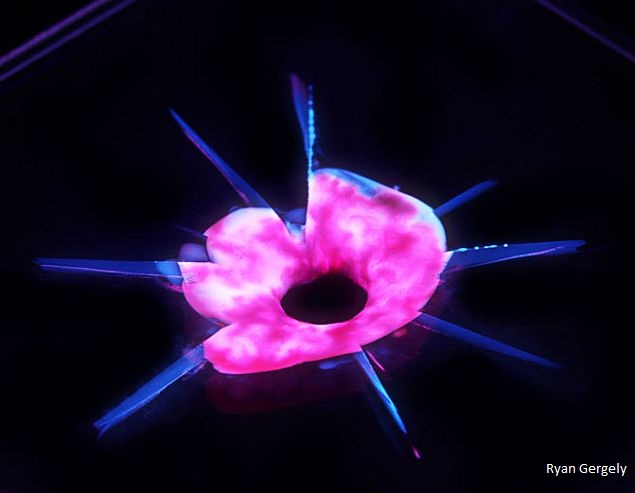- Home
- Science
- Science News
- Meet a Plastic That 'Heals' Damage by Clotting Like Blood
Meet a Plastic That 'Heals' Damage by Clotting Like Blood

A plastic that can heal itself to repair even large holes sounds like science fiction but this kind of technology is getting closer to real world use. There are already examples of self-healing polymers which canfix small amounts of damage - famously, the back of the LG G Flex (Review | Images) is made of aself-healing polymer, and can recover from small scratches. Large holesare however, much harder to repair.
(Also See: LG G Flex's Self-Healing Ability Gets Filmed, Seems Faster in Warm Conditions)
However, as a report in BBC News explains, this new polymer can patch holes up to 3cm wide, 100 times bigger than any similar materials before.
The polymer is described in scientific journal Science by Professor Scott White and his colleagues as "a vascular synthetic system that restores mechanical performance in response to large-scale damage."
The inspiration for the project came from the "regenerative power of tissues and organs in biology" which acts like clotting blood to fills gaps with scaffolds that can restore impacted regions that exceeded 35mm in diameter within 20 minutes, and restoration of mechanical function within 3 hours.
In the journal,White noted, "After restoration of impact damage, 62 percent of the total absorbed energy was recovered in comparison with that in initial impact tests."
To work, the materials first form a scaffold that conforms to the shape of the hole, and then form chemical bonds to harden, and form a solid structure. The new material could inspire breakthroughs for far greater damage resistant materials, which could beuseful in a number of different scenarios. Imagine, for example, a roadwhich doesn't have to be frequently repaved, and won't form potholes. Or a more mundane use, such as a phone that doesn't show scratches, for that matter.
This is a major breakthrough, but it is not somethingyou're going to find in your electronics and other devices soon. "When damage is unpredictable and uncontrolled, more complex and interconnected vascular networks will be necessary," White wrote.
Existingtechnologies have proven to have their limits. With the LG G Flex, we have found some scratches which will not go away. The work which White and his colleagues are doing might still be looking for solutions to unpredictable and uncontrolled damage, but perhaps it can be adapted forsmaller scale solutions and be used to make our phones and other devices, permanently pristine.
You can see a video explaining the process below:
For the latest tech news and reviews, follow Gadgets 360 on X, Facebook, WhatsApp, Threads and Google News. For the latest videos on gadgets and tech, subscribe to our YouTube channel. If you want to know everything about top influencers, follow our in-house Who'sThat360 on Instagram and YouTube.
Related Stories
- Samsung Galaxy Unpacked 2025
- ChatGPT
- Redmi Note 14 Pro+
- iPhone 16
- Apple Vision Pro
- Oneplus 12
- OnePlus Nord CE 3 Lite 5G
- iPhone 13
- Xiaomi 14 Pro
- Oppo Find N3
- Tecno Spark Go (2023)
- Realme V30
- Best Phones Under 25000
- Samsung Galaxy S24 Series
- Cryptocurrency
- iQoo 12
- Samsung Galaxy S24 Ultra
- Giottus
- Samsung Galaxy Z Flip 5
- Apple 'Scary Fast'
- Housefull 5
- GoPro Hero 12 Black Review
- Invincible Season 2
- JioGlass
- HD Ready TV
- Laptop Under 50000
- Smartwatch Under 10000
- Latest Mobile Phones
- Compare Phones
- Moto G15 Power
- Moto G15
- Realme 14x 5G
- Poco M7 Pro 5G
- Poco C75 5G
- Vivo Y300 (China)
- HMD Arc
- Lava Blaze Duo 5G
- Asus Zenbook S 14
- MacBook Pro 16-inch (M4 Max, 2024)
- Honor Pad V9
- Tecno Megapad 11
- Redmi Watch 5
- Huawei Watch Ultimate Design
- Sony 65 Inches Ultra HD (4K) LED Smart TV (KD-65X74L)
- TCL 55 Inches Ultra HD (4K) LED Smart TV (55C61B)
- Sony PlayStation 5 Pro
- Sony PlayStation 5 Slim Digital Edition
- Blue Star 1.5 Ton 3 Star Inverter Split AC (IC318DNUHC)
- Blue Star 1.5 Ton 3 Star Inverter Split AC (IA318VKU)

















